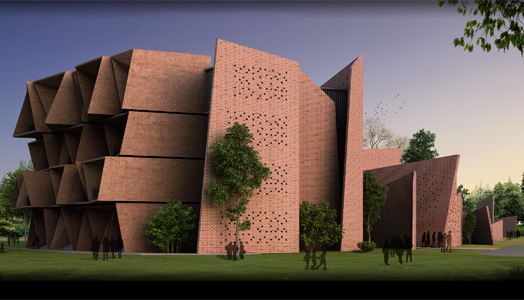By Marina Correa & Savitha Hira
Photography: Courtesy the architect
 |
| SDS School Gurgaon |
Whilst ‘neo-futurist
architecture’ as a term evolved in the 1960’s, characterized by an ‘uninhibited architectural
approach’, the prolific global mushrooming of ‘iconic’ built forms that we see
in present times, spurred Team IAnD to probe the larger picture of what makes architecture
iconic and what is the response it elicits…
As we look at the plans, layout and models of ace architect Sanjay Puri’s 3 imminent school façades, we are struck by their unconventional built forms; the three outer skins seem elaborate: hexagonal modules sheath the GI School and jaali-screen walls envelope the 14-storey Mulund School - both in Mumbai; while the SDS School in Gurgaon has numerous screen walls wrapping its ancillary spaces, making them sculptural - an aspect not associated with school buildings in India.
As we look at the plans, layout and models of ace architect Sanjay Puri’s 3 imminent school façades, we are struck by their unconventional built forms; the three outer skins seem elaborate: hexagonal modules sheath the GI School and jaali-screen walls envelope the 14-storey Mulund School - both in Mumbai; while the SDS School in Gurgaon has numerous screen walls wrapping its ancillary spaces, making them sculptural - an aspect not associated with school buildings in India.
.jpg) |
| Mulund School, Mumbai |
.jpg) |
| Mulund School, Mumbai |
If you look at any of Sanjay’s
buildings, for example, the recently built 72 screens in Jaipur or Chrome Hotel
in Kolkata or Auriga restaurant in Mumbai – they all have these angular
sculptural building skins. Sculptural, asymmetrical, non-linear, alien and
dynamic are words that often describe his structures. So, how does he arrive at
such built forms? “I am inspired anywhere and by anything,” comes the pat
reply. Elaborating on his muses, Sanjay relates how once he saw a truck-full of
pipes moving up and down and that became his inspiration for a plan, which is
yet to be realized, as no Indian builder is willing to back such an
unconventional design. Ironically, the plan featured in an international architectural
magazine and a developer in Amsterdam evinced interest in wanting to realize
it.
Such parametrically-designed
buildings have long been the staple of structures overseas, but are slowly
surfacing in India, as people are getting globally synthesized and developers’
reluctance waning in the face of such sustainable and sculptural marvels,
informs Sanjay. World over too, when we study individual projects like the Burj
Khalifa, Helix Hotel in Abu Dhabi, architecture by the likes of Zaha Hadid,
Coop Himmelblau, Frank Gehry and several others,
.jpg) |
| GI School, Ghatkopar, Mumbai |
Returning to Sanjay’s 3
schools, each design is completely sustainable and rooted in context. Limited
ground area in the Mulund and G.I. schools has spawned internal courtyards,
terrace spaces, spill-out areas and play on levels to augment a spatial feel; and
given its high-rise nature, negate any kind of claustrophobia. In both schools,
the skin is derived purely from a climatic response, harnessing indirect
sunlight and fostering ample ventilation – working on an annual energy savings of around
30%. In case of the SDS School, space
is plentiful, so the built form is derived after carving out linear
courtyards on every floor. The glass façade classrooms facing north get the
warmth of indirect sunlight, thus reducing heat gain.
.jpg) |
| SDS School Gurgaon |
So, what makes architecture
iconic? Is it the freedom that an architect enjoys with the support of advanced
CAD that gives wings to his imagination and he can create a no-holds-barred
built form? Is it the influx of several futuristic architectural buildings
around the world that push a professional to try and compete with the idea of
creating something awe-inspiring, eyeball-grabbing?
“Yes”, says Sanjay, the
positive response of the layman is a spearheading factor; as is software
support like Rhino among others, and newer technological methods like BIM
calculations, 3D printing and the like. Where
once architects built a series of models, sliced their sections, crumpled and
burnt paper, etc., giving vent to their strong musings, striving to accomplish
in reality what they passionately believed to be the structure; is now more easily handled and aided by the computer.
“So architecture isn’t conceived in isolation or as a deliberate attempt to
prove something but as a site-specific design response. And in the bargain, if
it elicits a surprise element, then what more can one ask for?” he says, smilingly.
But there is the other side
of the coin too. When architects tend to go all out with their imagery, there are
brickbats too; like the recent flak Ar. Frank Gehry received for his sprightly
Bio Museum in Panama. “But certainly, bucking the trend and creating outstanding
work a la Frank Gehry or Coop
Himmelblau is definitely worth any possible backlash!” rejoins Sanjay. So true!!
Ar. Sanjay Puri's Top Picks~ in India & Overseas
.jpg) |
| . |
.jpg) |
| . |

.jpg)
.jpg)
.gif)
No comments :
Post a Comment